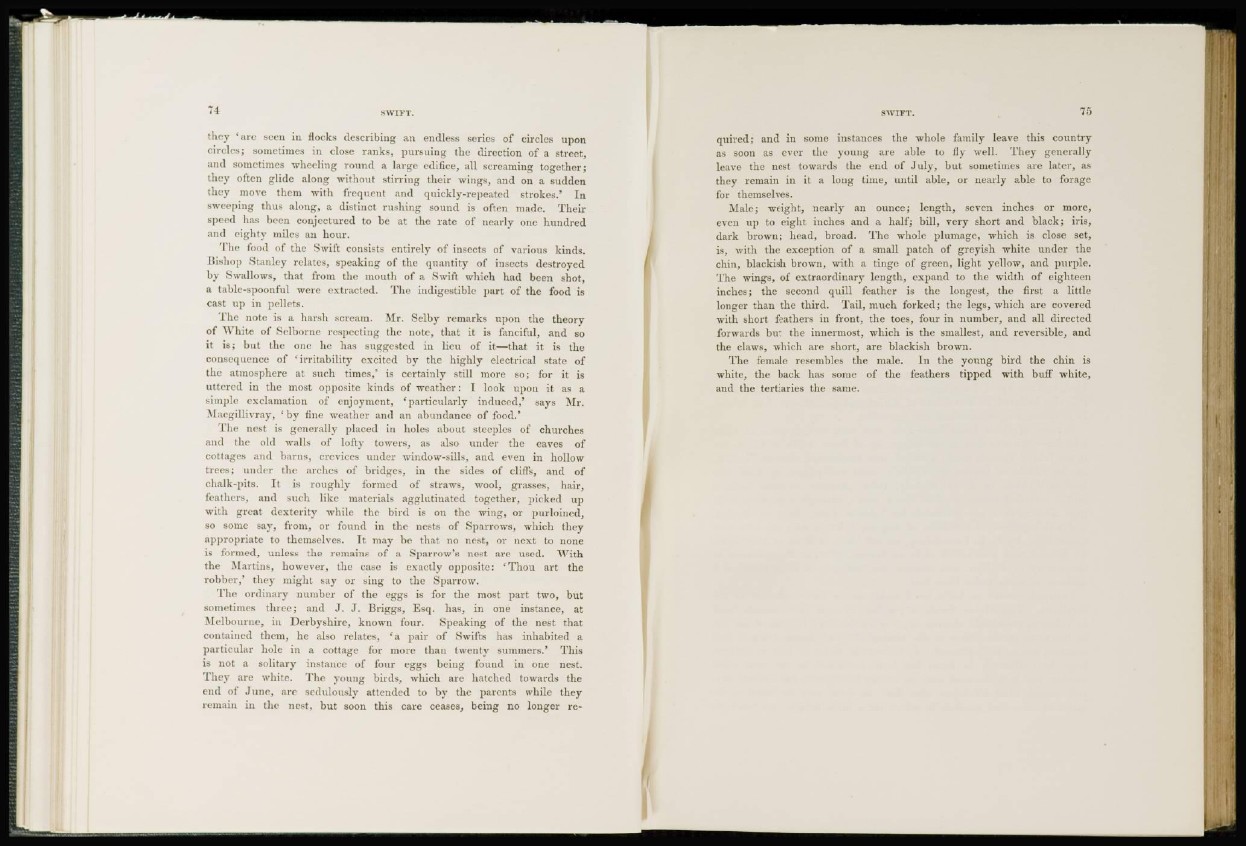
they ' are seen in flocks describing an endless series of circles upon
circles; sometimes in close ranks, pursuing the direction of a street,
and sometimes wheeling round a large edifice, all screaming together;
they often glide along without stirring their wings, and on a sudden
they move them with frequent and quickly-repeated strokes.' In
sweeping thus along, a distinct rushing sound is often made. Their
speed has been conjectured to be at the rate of nearly one hundred
and eighty miles an hour.
The food of the Swift consists entirely of insects of various kinds.
Bishop Stanley relates, speaking of the quantity of insects destroyed
by Swallows, that from the mouth of a Swift which had been shot,
a table-spoonful were extracted. The indigestible part of the food is
cast up in pellets.
The note is a harsh scream. Mr. Selby remarks upon the theory
of White of Selborne respecting the note, that it is fanciful, and so
it is; but the one he has suggested in lieu of it—that it is the
consequence of 'irritability excited by the highly electrical state of
the atmosphere at such times,' is certainly still more so; for it is
uttered in the most opposite kinds of weather: I look upon it as a
simple exclamation of enjoyment, ' particularly induced,' says Mr.
Macgillivray, * by fine weather and an abundance of food.*
The nest is generally placed in holes about steeples of churches
and the old walls of lofty towers, as also under the eaves of
cottages and barns, crevices under window-sills, and even in hollow
trees; under the arches of bridges, in the sides of cliffs, and of
chalk-pits. It is roughly formed of straws, wool, grasses, hair,
feathers, and such like materials agglutinated together, picked up
with great dexterity while the bird is on the wing, or purloined,
so some say, from, or found in the nests of Sparrows, which they
appropriate to themselves. It may be that no nest, or next to none
is formed, unless the remains of a Sparrow's nest arc used. With
the Martins, however, the case is exactly opposite: 'Thou art the
robber,' they might say or sing to the Sparrow.
The ordinary number of the eggs is for the most part two, but
sometimes three; and J. J. Briggs, Esq. has, in one instance, at
Melbourne, in Derbyshire, known four. Speaking of the nest that
contained them, he also relates, 'a pair of Swifts has inhabited a
particular hole in a cottage for more than twenty summers.' This
is not a solitary instance of four eggs being found in one nest.
They are white. The young birds, which arc hatched towards the
end of June, are sedulously attended to by the parents while they
remain in the nest, but soon this care ceases, being no longer required;
and in some instances the whole family leave this country
as soon as ever the young are able to fly well. They generally
leave the nest towards the end of July, but sometimes are later, as
they remain in it a long time, until able, or nearly able to forage
for themselves.
Male; weight, nearly an ounce; length, seven inches or more,
even up to eight inches and a half; bill, very short and black; iris,
dark brown; head, broad. The whole plumage, which is close set,
is, with the exception of a small patch of greyish white under the
chin, blackish brown, with a tinge of green, light yellow, and purple.
The wings, of extraordinary length, expand to the width of eighteen
inches; the second quill feather is the longest, the first a little
longer than the third. Tail, much forked; the legs, which arc covered
with short feathers in front, the toes, four in number, and all directed
forwards but the innermost, which is the smallest, and reversible, and
the claws, which are short, are blackish brown.
The female resembles the male. In the young bird the chin is
white, the back has some of the feathers tipped with buff white,
and the tertiaries the same.